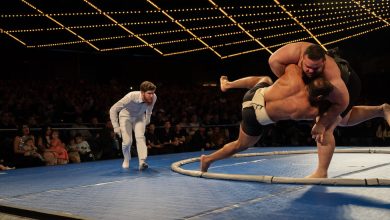In Milan, an Iconic Stadium Isn’t Going Down Without a Fight

As he watched the soccer game playing out on television, the Milanese writer and actor Gianfelice Facchetti felt an emotional tug that he thought might be leading him toward his next book.
It was during Italy’s first coronavirus lockdown, and Facchetti’s favorite team, Inter Milan, had been forced to play its matches behind closed doors. The decision left its longtime home, the 80,000-seat Giuseppe Meazza Stadium, more commonly known as the San Siro, devoid of atmosphere, and amid the silence Facchetti’s mind began to drift.
He thought back not only to fond memories and tense moments in the arena where his father, Giacinto, had represented Inter and Italy but also to news stories that had been circulating for months describing plans by the teams that share the nearly century-old stadium, Inter and A.C. Milan, to abandon the stadium or, worse, demolish it.

The San Siro’s contrast of cylindrical towers and long red trusses has admirers among fans and architects alike.Credit…Camilla Ferrari for The New York Times
“I was thinking, when I started to write: If you want to destroy this place, this special place, it would be helpful to know the history,” Facchetti said.
The book that sprang from that first impulse, “Once Upon a Time in San Siro,” was part history and part coping mechanism, Facchetti admits. He and many Inter fans, like those who support Milan, are still coming to terms with the fact that their “seconda casa,” or “second home,” could one day be no more.
On the list of sins that stir the emotions of soccer fans, assaults on tradition surely rank near the top, particularly when maximizing revenue is seen as the motivation. Even minor changes, such as a new shirt design or an alteration of a club crest, can be like grabbing soccer’s third rail. For the same reasons, stadiums hold a special place in the minds of many supporters, serving as a physical embodiment of a lifetime of sporting experiences. A club’s decision to replace one, then, can bring not only monumental costs but also howls of protest.
Yet replace them they do.
From 2010 to 2020, 153 new stadiums were built across Europe, at a reported cost of more than $20 billion. Madrid got one. So did Stockholm and St. Petersburg. London opened two.
Only 1 percent of this investment was made in Italy, though. Most professional teams’ stadiums in the country are both antiquated and publicly owned — only two have opened this century. And a new generation of deep-pocketed foreign owners with American tech, finance and retail fortunes are eager to create new revenue streams that they feel their clubs need to compete with richer rivals in England and elsewhere.
Change, though, is not as simple as drawing up plans and digging a stadium-size hole. When Milan and Inter announced their intention to build a new stadium more than three years ago, the subtext was that the San Siro — one of the largest stadiums in Europe and the site of four European Cup finals and matches in two World Cups — was no longer fit for its job in an age of luxury suites and corporate hospitality. Ever since, a debate about the arena’s future has split not only the teams’ wealthy owners and longtime fans but also politicians, preservationists and architects.
“Italy is like an open-air museum: We have a lot of heritage,” said Massimo Roj, a Milanese architect and Inter fan who put forward one of the proposed designs for a new stadium in Milan. “We have to think that the San Siro is an old building. Your memory now is there, but, in 10 years time, we’ll be in another stadium, called San Siro again.”
The first iteration of the San Siro opened in 1926 and was revolutionary for Italy because it was English in design, featuring four independent stands that sat square to the playing surface and no running track. It was expanded after the 1934 World Cup and again in the 1950s after Inter became a co-tenant.
The most recent alteration came before Italy hosted the 1990 World Cup, when the architects Giancarlo Ragazzi and Enrico Hoffer and the engineer Leo Finzi added what became the stadium’s trademark: 11 cylindrical towers with helical ramps that allowed spectators to reach a new third tier. A roof made of red trusses was placed on top, its lines an angular — and to devotees, iconic — contrast to the circular forms that supported them.
Yet in the decades after, the need for further refurbishments became increasingly apparent, fans said, as the Italian industrialists who once bankrolled the Milanese clubs sold their teams and Russian billionaires and Persian Gulf petrodollars rewrote the economics of elite European soccer.
Many clubs in Serie A, arguably the world’s richest and most attractive league in the 1990s, now face growing debts and unsustainable budgets. Inter, for example, had to break up last season’s title-winning side just to meet its payroll.
“In terms of revenues, we have, both Milan and Inter, revenues of around 35 to 40 million euros a year” — roughly $37 million to $42 million — “from the stadium, while our competitors are about €100 million,” the chairman of Milan, Paolo Scaroni, said in an interview.
The teams say they initially considered changes to the current San Siro but quickly concluded logistical issues and delays would be too much to overcome. What they have proposed instead is a 60,000-seat arena to be built next door. Once it is constructed, the current San Siro will come down and make way for public space that may include elements of its iconic towers and ramps, according to the designs by Populous, the American architecture firm whose proposal was chosen.
“I think these buildings are containers, and therefore the old buildings have such emotion attached to them that the idea that some of it can remain, if it can be there as a marker of history of what was before, is quite a nice idea,” said Chris Lee, a managing director of Populous. “One has to be careful about trying to transfer too much of that, literally, into new buildings, where it can easily tip into the pastiche of trying to recreate a building.”
Opposition is to be expected, Lee said. In Milan, it has emerged in various forms.
Milan’s mayor, Beppe Sala, while generally supportive of the project, has warned both clubs that the city-owned San Siro would remain until at least 2026, when it is expected to host the opening ceremony of the Winter Olympics.
A different group, the Si Meazza committee, has taken a hard-line approach, challenging the mere idea of the demolition of the San Siro, which its most prominent voices — lawyers, concert promoters and former politicians — described as a symbol of Milan known around the world, a stage on which Diego Maradona, Bob Dylan and Beyoncé have performed. Other critics pointed to the ecological impact of tearing down a stadium and highlighted renderings that they argued proved the job could be done for half the cost while saving the original arena.
Some fear, though, the die may have been cast: A future without the San Siro received the tacit approval of Italy’s heritage authority in 2020 when it raised no objections to the stadium’s demolition. In November, the project was declared in the public interest (with certain conditions) by city officials.
A month later, the clubs chose the Populous design: It features a stadium enveloped by a steel-and-glass galleria, reminiscent of the famed luxury-shopping district in the center of Milan, as the centerpiece of an expansive park on the site.
But the legal fight over building any of it may not be over.
The next steps for the clubs will be to put their proposals to the public; that is expected to happen this summer. Municipality decisions can be appealed, and other bureaucratic hurdles can take months to resolve, said Scaroni, the Milan chairman. Aware of those potential delays, the clubs have said that they are also considering a Plan B: a site elsewhere in Milan.
“More than three years, we are still debating about our master plan,” said Alessandro Antonello, the Inter chief executive. “Unfortunately, yes, we started with a very exciting energy three years ago, and now, after three years, we are still waiting for some answers from the municipality. So, now, for us, the main priority is to build a new stadium, whatever the location.”
For opponents like Facchetti, though, the delays are just one more hopeful sign their beloved San Siro might yet be saved. Another good omen, he said, came this spring: His publisher has approved a second printing of his book.
“It’s a sign,” Facchetti said. “People still want to speak about the San Siro and its destiny.”



